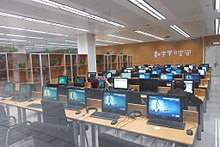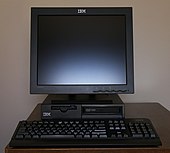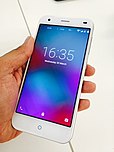Classes of computers
This article needs additional citations for verification. (October 2007) |
Desktop computer (IBM ThinkCentre S50 with monitor)
Smartphone (LYF Water 2)
)
Computers can be classified, or typed, in many ways. Some common classifications of computers are given below.
Classes by purpose
| Classes of Computers | |||||||||||||||||||||||||||||||||||||||||||||||||||||||||||||||||||||||||||||||||||||||||||||||||||||||||||||||||||||||||||||||||||||||||||||||||||||||||||||||||||||||||||||||||||||||||||||||||||||||||||
|---|---|---|---|---|---|---|---|---|---|---|---|---|---|---|---|---|---|---|---|---|---|---|---|---|---|---|---|---|---|---|---|---|---|---|---|---|---|---|---|---|---|---|---|---|---|---|---|---|---|---|---|---|---|---|---|---|---|---|---|---|---|---|---|---|---|---|---|---|---|---|---|---|---|---|---|---|---|---|---|---|---|---|---|---|---|---|---|---|---|---|---|---|---|---|---|---|---|---|---|---|---|---|---|---|---|---|---|---|---|---|---|---|---|---|---|---|---|---|---|---|---|---|---|---|---|---|---|---|---|---|---|---|---|---|---|---|---|---|---|---|---|---|---|---|---|---|---|---|---|---|---|---|---|---|---|---|---|---|---|---|---|---|---|---|---|---|---|---|---|---|---|---|---|---|---|---|---|---|---|---|---|---|---|---|---|---|---|---|---|---|---|---|---|---|---|---|---|---|---|---|---|---|---|
| |||||||||||||||||||||||||||||||||||||||||||||||||||||||||||||||||||||||||||||||||||||||||||||||||||||||||||||||||||||||||||||||||||||||||||||||||||||||||||||||||||||||||||||||||||||||||||||||||||||||||||
| Notes:
| |||||||||||||||||||||||||||||||||||||||||||||||||||||||||||||||||||||||||||||||||||||||||||||||||||||||||||||||||||||||||||||||||||||||||||||||||||||||||||||||||||||||||||||||||||||||||||||||||||||||||||
Microcomputers (personal computers)
Microcomputers became the most common type of computer in the late 20th century. The term “microcomputer” was introduced with the advent of systems based on single-chip microprocessors. The best-known[citation needed] early system was the Altair 8800, introduced in 1975. The term "microcomputer" has practically become an anachronism as it has fallen into disuse.[1]
These computers include:
- Desktop computers – A case put under or on a desk. The display may be optional, depending on use. The case size may vary, depending on the required expansion slots. Very small computers of this kind may be integrated into the monitor.
- Rackmount computers – The cases of these computers fit into 19-inch racks, and maybe space-optimized and very flat. A dedicated display, keyboard, and mouse may not exist, but a KVM switch or built-in remote control (via LAN or other means) can be used to gain console access. Many servers are rackmount computers and data centers may have dozens or hundreds of racks with hundreds or thousands of rackmount computers acting as servers.
- In-car computers (entertainment, navigation, etc.
- notebook computers– Portable and all in one case.
- touch-screen, entirely replacing the physical keyboard.
- palmtop computers– Small handheld personal computers with limited hardware specifications.
- Programmable calculator– Like small handhelds, but specialized in mathematical work.
- Video game consoles– Fixed computers built specifically for entertainment purposes.
- Handheld game consoles – The same as game consoles, but small and portable.
Minicomputers (mid-range computers)
Mainframe computers
The term mainframe computer was created to distinguish the traditional, large, institutional computer intended to service multiple users from the smaller, single-user machines. These computers are capable of handling and processing very large amounts of data quickly. Mainframe computers are used in large institutions such as government, banks, and large corporations. They are measured in MIPS (million instructions per second) and can respond to hundreds of millions of users at a time[citation needed].
Supercomputers
A supercomputer is focused on performing tasks involving intense numerical calculations such as weather forecasting, fluid dynamics, nuclear simulations, theoretical astrophysics, and complex scientific computations. A supercomputer is a computer that is at the front-line of current processing capacity, particularly speed of calculation. The term supercomputer itself is rather fluid, and the speed of today's supercomputers tends to become typical of tomorrow's ordinary computer. Supercomputer processing speeds are measured in floating-point operations per second, or FLOPS. An example of a floating-point operation is the calculation of mathematical equations in real numbers. In terms of computational capability, memory size and speed, I/O technology, and topological issues such as bandwidth and latency, supercomputers are the most powerful, are very expensive, and not cost-effective just to perform batch or transaction processing.
Classes by function
Servers
- A back end", which runs on the server and handles tasks such as data analysis and storage.
- A file server does not normally perform computational tasks or run programs on behalf of its client workstations but manage and store a large collection of computer files. The crucial function of a file server is storage. File servers are commonly found in schools and offices, where users use a local area network to connect their client computers and use Network-attached storage (NAS) systems to provide data access.
- A Hypertext Transfer Protocol (HTTP). Pages delivered are most frequently HTML documents, which may include images, style sheets and scriptsin addition to the text content.
- A data encryptionand user authentication. These provide GUI sessions that can be used by client PCs that work someway like a remote control. Only the screen (and audio) output is shown on the client. The GUI applications run on the server, data (like in files) would be stored in the same LAN, thus avoiding problems, should a client PC be damaged or stolen.
A server may run several virtual machines (VMs) for different activities, supplying the same environment to each VM as if it ran on dedicated hardware. Different operating systems (OS) can therefore be run at the same time. This technology approach needs special hardware support to be useful and was first the domain of mainframes and other large computers. Nowadays, most personal computers are equipped for this task, but for long-term operation or critical systems, specialized server hardware may be needed.
Another approach is to implement VMs on the operating system level, so all VMs run on the same OS instance (or incarnation), but are fundamentally separated to not interfere with each other.
Workstations
Workstations are computers that are intended to serve one user and may contain special hardware enhancements not found on a personal computer. By the mid-1990s personal computers reached the processing capabilities of mini computers and workstations. Also, with the release of multi-tasking systems such as OS/2, Windows NT and Linux, the operating systems of personal computers could do the job of this class of machines. Today, the term is used to describe desktop PCs with high-performance hardware. Such hardware is usually aimed at a professional, rather than enthusiast, market (e.g. dual-processor motherboards, error-correcting memory, professional graphics cards).
Information appliances
Embedded computers
Embedded computers are computers that are a part of a machine or device. Embedded computers generally execute a program that is stored in non-volatile memory and is only intended to operate a specific machine or device. Embedded computers are very common. The majority are microcontrollers. Embedded computers are typically required to operate continuously without being reset or rebooted, and once employed in their task the software usually cannot be modified. An automobile may contain a number of embedded computers; however, a washing machine or DVD player would contain only one microcontroller. Embedded computers are chosen to meet the requirements of the specific application, and most are slower and cheaper than CPUs found in a personal computer.
Classes by usage

Public computer
Public computers are open for public uses, possibly as an Interactive kiosk. There are many places where one can use them, such as cybercafes, schools and libraries.
They are normally fire-walled and restricted to run only their pre-installed software[citation needed]. The operating system is difficult to change and/or resides on a file server. For example, "thin client" machines in educational establishments may be reset to their original state between classes. Public computers are generally not expected to keep an individual's data files.
Personal computer
A
These are computers where different people might log on at different times; unlike public computers, they would have usernames and passwords assigned on a long-term basis, with the files they see and the computer's settings adjusted to their particular account. Often the important data files will reside on a central file server, so a person could log onto different computers yet still see the same files. The computer (or workstation) might be a "thin client" or X terminal, otherwise it may have its own disk for some or all system files, but usually will need to be networked to the rest of the system for full functionality. Such systems normally require a system administrator to set up and maintain the hardware and software.
Display computer
Computers that are used just to display selected material (usually audio-visual, or simple slide shows) in a shop, meeting or trade show. These computers may have more capabilities than they are being used for; they are likely to have
Classed by generation of computer technology
The history of computing hardware is often used to reference the different generations of computing devices:
- First generation computers (1940-1955): It used earliest computerswere less flexible in their programmability.
- Second generation computers (1956-1963): It used discrete transistors, and so were smaller and consumed less power.
- Third generation computers (1964-1970): It used Very-large-scale integration (VLSI)with over ten billion transistors in a single silicon-based IC "chip".
- Fourth generation computers(1971–present): It uses Microprocessors, as millions of ICs were built onto a single silicon-based chip. Since then form factor of computers reduced, task processing & graphic rendering improved and it became more battery-powered with the advent of personal mobile devices such as laptops, tablets, smartphones etc.
See also
- Lisp machine
- List of computer size categories
- Bell's law of computer classes
- Analog computers
- Feng's classification
- Flynn's taxonomy
References
- ^ "Google Books Ngram Viewer". books.google.com. Retrieved 2023-11-10.
- ^ "Google Books Ngram Viewer". books.google.com. Retrieved 2023-11-10.
- ISBN 978-0-375-42277-5.




